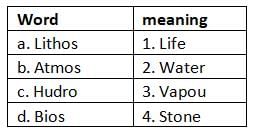Class 5 Exam > Class 5 Tests > Test: Major Landforms- 1 - Class 5 MCQ
Test: Major Landforms- 1 - Class 5 MCQ
Test Description
10 Questions MCQ Test - Test: Major Landforms- 1
Test: Major Landforms- 1 for Class 5 2025 is part of Class 5 preparation. The Test: Major Landforms- 1 questions and answers have been prepared
according to the Class 5 exam syllabus.The Test: Major Landforms- 1 MCQs are made for Class 5 2025 Exam.
Find important definitions, questions, notes, meanings, examples, exercises, MCQs and online tests for Test: Major Landforms- 1 below.
Solutions of Test: Major Landforms- 1 questions in English are available as part of our course for Class 5 & Test: Major Landforms- 1 solutions in
Hindi for Class 5 course.
Download more important topics, notes, lectures and mock test series for Class 5 Exam by signing up for free. Attempt Test: Major Landforms- 1 | 10 questions in 15 minutes | Mock test for Class 5 preparation | Free important questions MCQ to study for Class 5 Exam | Download free PDF with solutions
Test: Major Landforms- 1 - Question 1
Who were the first men to climb the highest mountain peak Mount Everest on 29th May 1953?
Detailed Solution for Test: Major Landforms- 1 - Question 1
Test: Major Landforms- 1 - Question 2
Elevation of land is measured from level of the sea which is taken as _________
Detailed Solution for Test: Major Landforms- 1 - Question 2
Detailed Solution for Test: Major Landforms- 1 - Question 3
Detailed Solution for Test: Major Landforms- 1 - Question 4
Test: Major Landforms- 1 - Question 5
The two main divisions of the earth’s surface are: 1.Continents and 2 __________
Detailed Solution for Test: Major Landforms- 1 - Question 5
Test: Major Landforms- 1 - Question 6
________ is a narrow zone where we find land, water and air together which contains all form of life.
Detailed Solution for Test: Major Landforms- 1 - Question 6
Test: Major Landforms- 1 - Question 7
Water covered by a large area of the earth’s surface and this area is called _________
Detailed Solution for Test: Major Landforms- 1 - Question 7
Test: Major Landforms- 1 - Question 8
The gaseous layers that surround the earth are called ___________
Detailed Solution for Test: Major Landforms- 1 - Question 8
Test: Major Landforms- 1 - Question 9
The solid portion of the earth on which we live is called ________
Detailed Solution for Test: Major Landforms- 1 - Question 9
Information about Test: Major Landforms- 1 Page
In this test you can find the Exam questions for Test: Major Landforms- 1 solved & explained in the simplest way possible.
Besides giving Questions and answers for Test: Major Landforms- 1, EduRev gives you an ample number of Online tests for practice
Download as PDF




















